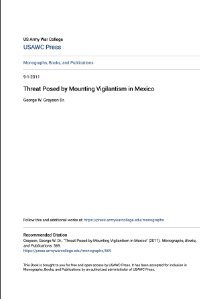By Eugenio Weigend Vargas, Michelle Degli Esposti, Stephen Hargarten, Laura Vargas and Jason E. Goldstick
Background
Globally, Mexico is one of six countries with the highest level of firearm mortality. While previous studies have examined firearm mortality in Mexico before 2015, increases in violence since then highlight the need for an updated analysis. In this study, we examined changes in firearm-related deaths in Mexico from 2015 to 2022 and described these deaths by key demographic groups, incident location, and state of occurrence. Data came from Mexico’s Instituto Nacional de Estadistica y Geografia (INEGI), a federal agency that collects and reports national population data. We used descriptive statistics to analyze rates, proportions, and percentage changes in firearm mortality, and we displayed temporal trends using time plots and special trends using maps.
Results
Firearm deaths increased in Mexico from 2015 to 2018 but slightly decreased from 2018 to 2022. Homicides presented the highest increase and the highest proportion of firearm-related deaths from 2015 to 2022. Victims were primarily males but rates among women increased at a higher proportion (99.5% vs 53.5%). One third of victims were 20–29y but rates among children and adolescents (10–9y) increased at a higher proportion. Most firearm-related deaths occurred in streets or public spaces but the percentage of incidents occurring in households have increased. State-level rates and percentage changes varied significantly. States with higher rates of firearm mortality coincide with those involving conflict among organized criminal organizations.
Conclusion
Firearm mortality in Mexico is a major public health burden. The epidemiology of firearm-related deaths in Mexico varies by intent, demographics, location, and states. To mitigate this challenge, multiple solutions are required.
Introduction
Previous studies have documented increases in firearm mortality in Mexico from 1990 to 2015 (Dare et al. 2019). Reports from nonprofit organizations and news outlets indicate further increases since 2015, (particularly firearm homicides associated with organized crime) (Calderon et al. 2020), but comprehensive characterization of those trends is lacking. Organized criminal groups continue to operate in Mexico and roughly 213 k firearms are trafficked from the US every year (McDougal et al. 2014). In this regard, further increases in firearm mortality would threaten the future economy and health of Mexico (Peters et al. 2020; Aburto et al. 2016), and yet the lack of precise epidemiological information limits the ability to address this growing national problem with evidence-based programs and policies. In this analysis, we document changes in firearm-related deaths in Mexico from 2015 to 2022 and describe these deaths by key demographic groups (e.g., sex, age, and urbanicity), incident location (e.g., households or public spaces) and states where they occurred.
Methods
Data on causes of death were collected from Mexico’s Instituto Nacional de Estadistica y Geografia (INEGI), a national vital statistic database that has previously been used to examine firearm mortality in Mexico (Dare et al. 2019; Instituto Nacional de Estadística y Geografía 2023a). INEGI collects annual mortality data and provides information on year of occurrence (Instituto Nacional de Estadística y Geografía 2023b). We merged datasets from 2015 to 2022. We excluded deaths that occurred/registered before 2015 and those where year of occurrence was unknown (n = 432), as well as deaths that occurred outside of Mexico (n = 2).
In line with previous studies (Degli Esposti et al. 2023; Cunningham et al. 2018), we identified firearm deaths using the International Classification of Disease (ICD-10) codes for firearm homicide (X93–X95 and U01.4), firearm suicide (X72–X74), unintentional firearm deaths (W32–W34), and firearm deaths of undetermined intent (Y22–Y24). Firearm deaths were further disaggregated by sex and age group (< 10y; 10–19y; 20–29y; 30–39; 40–49y; 50–59y; 60–69y; 70y+) and geographic information (urbanicity, incident location, state of occurrence). Urbanicity was defined using INEGI’s predetermined categories of urbanicity (urban and rural). Similarly, incident location was defined using INEGI’s eight predetermined categories of where deaths occurred (household, school or office, sport fields, streets or public spaces, commercial areas, industrial areas, farms/ranches, and other).
We used descriptive statistics to examine pooled 2015–2022 rates, annual rates for 2015 and 2022 separately, as well as percentage changes (in rates) from 2015 to 2022 across categories of intent, sex, age groups, and state of occurrence. To obtain rates, we used population estimates (by year, sex, age group, and state) provided by Mexico’s Consejo Nacional de Población (CONAPO) (Consejo Nacional de Población 2024). We also examined the percentage of firearm related deaths within categories defined by urbanicity, location, intent, and demographics. We displayed these percentages for 2015, 2022, and the total pooled 2015–2022 period.
Results
We examined 188,397 firearm-related deaths in Mexico from 2015 to 2022. Rates of firearm-related deaths increased by 88.2% from 2015 to 2018 and decreased by 16.7% from 2018 to 2022 (Fig. 1). Homicide accounted for 92.2% of firearm deaths (Table 1) during this period and experienced the highest percentage increase (62.7%) from 2015 (10.37 per 100 k) to 2022 (16.87 per 100 k). Rates of undetermined firearm-related deaths and unintentional shootings also increased during this period (Table 1), while firearm suicide decreased by 23.4% (from 0.47 per 100 k in 2015 to 0.36 per 100 k in 2022).
Injury Epidemiology; 2024











